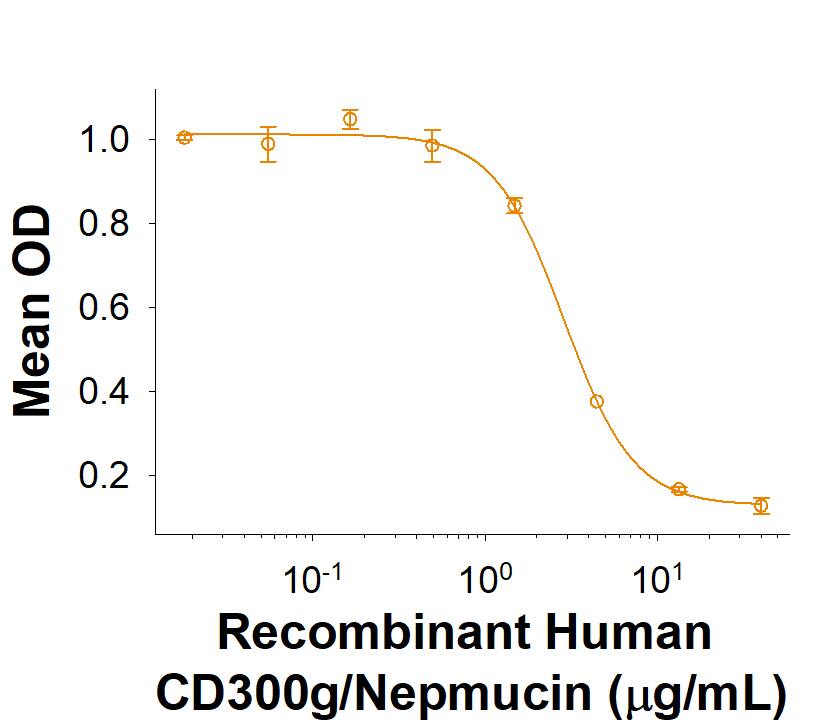Recombinant Human CD300g/Nepmucin Fc Chimera Protein, CF
R&D Systems, part of Bio-Techne | Catalog # 10615-NE

Key Product Details
Source
Accession #
Structure / Form
Conjugate
Applications
Product Specifications
Source
| Human CD300g/Nepmucin (Leu19-Leu249) Accession # AAH25395.1 |
IEGRMD | Human IgG1 (Pro100-Lys330) |
| N-terminus | C-terminus |
Purity
Endotoxin Level
N-terminal Sequence Analysis
Predicted Molecular Mass
SDS-PAGE
Activity
The ED50 for this effect is 0.5-5 μg/mL.
Scientific Data Images for Recombinant Human CD300g/Nepmucin Fc Chimera Protein, CF
Recombinant Human CD300g/Nepmucin Fc Chimera Protein Bioactivity.
Measured by its ability to inhibit anti-CD3 antibody induced IFN-gamma secretion by human T cells. The ED50 for this effect is 0.5-5 μg/mL.Recombinant Human CD300g/Nepmucin Fc Chimera Protein SDS-PAGE.
2 μg/lane of Recombinant Human CD300g/Nepmucin Fc Chimera Protein (Catalog # 10615-NE) was resolved with SDS-PAGE under reducing (R) and non-reducing (NR) conditions and visualized by Coomassie® Blue staining, showing bands at 68-97 kDa and 140-200 kDa, respectively.Formulation, Preparation and Storage
10615-NE
| Formulation | Lyophilized from a 0.2 μm filtered solution in PBS. |
| Reconstitution | Reconstitute at 200 μg/mL in PBS. |
| Shipping | The product is shipped at ambient temperature. Upon receipt, store it immediately at the temperature recommended below. |
| Stability & Storage | Use a manual defrost freezer and avoid repeated freeze-thaw cycles.
|
Background: CD300g/Nepmucin
Nepmucin, also known as CMRF35-like molecule 9 (CLM-9), TREM-4 and CD300g, is a 75-95 kDa type I transmembrane O-glycosylated member of the CD300 family of molecules. Nepmucin (mucin not expressed in Peyer's Patches) is expressed on capillary endothelium and its expression appears to be influenced by factors that are locally produced in tissues (1, 2). Nepmucin contains a single V-type immunoglobulin domain and a mucin-like domain (3). Mature human nepmucin is composed of 314 amino acid (aa), containing 229 aa extracellular domain (ECD), a 21 aa transmembrane segment, and a 64 aa cytoplasmic region. Within the ECD, human nepmucin shares 53% aa identity with mouse nepmucin. Nepmucin plays a critical role in promoting lymphocyte transendothelial migration of high endothelial veins and mediates lymphocyte adhesion with endothelial cells by its Ig domain, which is independent of LFA-1 or VLA-4 adhesion pathway (3). Glycosylated nepmucin with MECA-79 epitope associate with L-selectin to mediate L-selectin-dependent lymphocyte rolling by its mucin-like domain (4). Expression of nepmucin is down-regulated in tumours and tumour-draining lymph nodes, indicating that the expression of nepmucin is negatively regulated by locally produced signals under these circumstances (2). Nepmucin induction can significantly improve the killing activity of CIK cells (5).
References
- Jin, S. et al. (2008) FEBS Lett. 582:3018.
- Umemoto, E. et al. (2013) PloS One. 8:e83681.
- Umemoto, E. et al. (2006) J. Exp. Med. 203:1603.
- Takatsu H, et al. (2006) Biochem. Biophys. Res. Commun. 348:183.
- Wang, Q. et al. (2017) Cent. Eur. J. Immunol. 42:117.
Alternate Names
Gene Symbol
UniProt
Additional CD300g/Nepmucin Products
Product Documents for Recombinant Human CD300g/Nepmucin Fc Chimera Protein, CF
Product Specific Notices for Recombinant Human CD300g/Nepmucin Fc Chimera Protein, CF
For research use only

